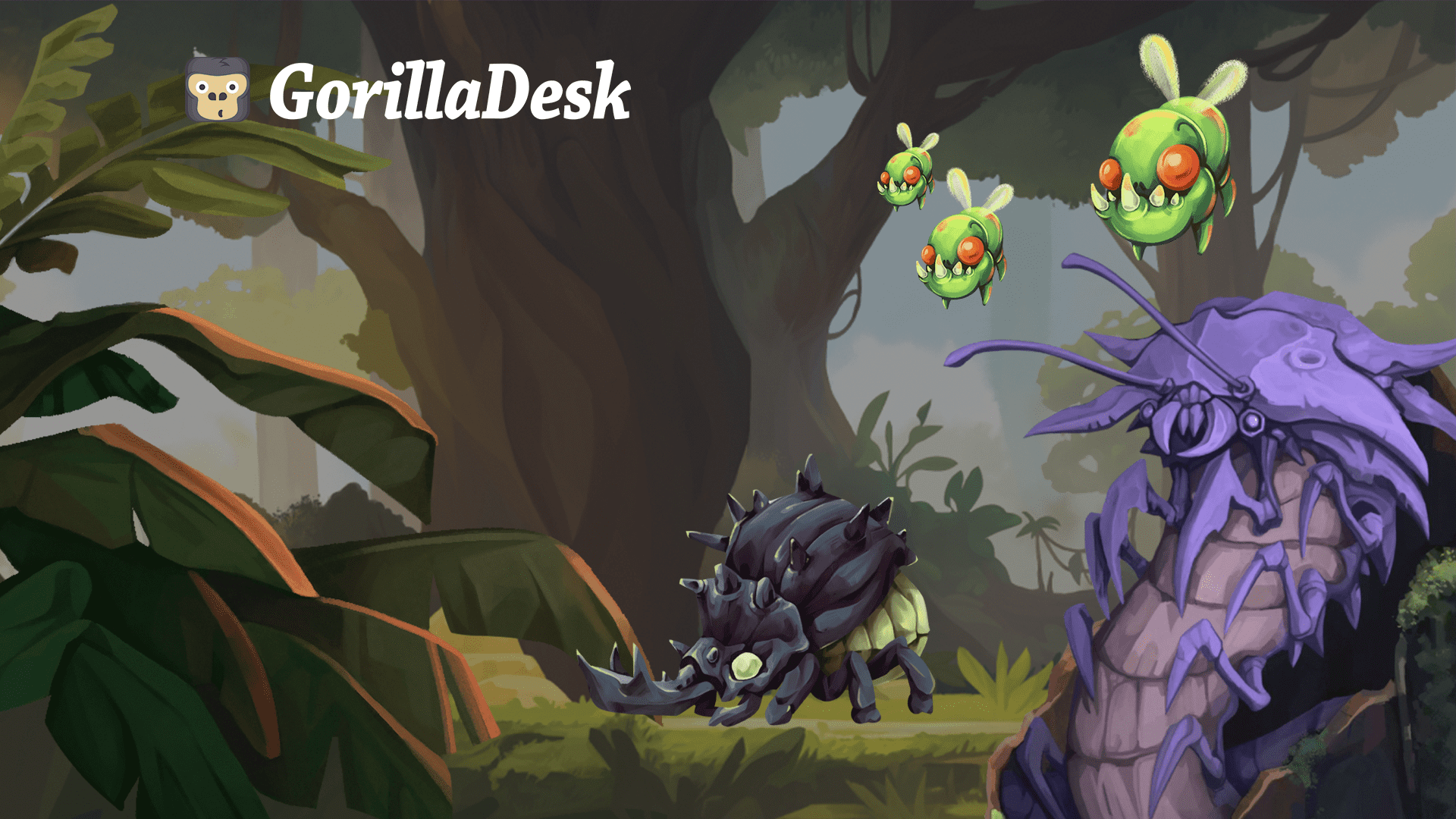The ultimate guide to different types of pest control services
GorillaDesk Staff

As an owner of a pest control company, you don’t want to stagnate and stunt business growth.
Since the industry is constantly evolving and customer demands are always shifting, staying competitive requires flexibility and innovation. Expanding your range of services isn’t just about offering more—it’s about offering better. Meeting diverse client needs, tapping into new revenue streams, and solidifying your position as a comprehensive solution provider can all help you get there.
By embracing a broader spectrum of pest control methods, you can enhance your service portfolio, attract a wider clientele, and build customer loyalty. Let’s explore diversifying your services as a compelling strategy for your pest control business.
Do different pest control methods offer better revenue?
The goal of diversifying your service offerings is to increase revenue, right? So you’ll want to consider the inherent trade-offs between one-off treatments and recurring maintenance plans—and find the perfect balance for your business.
One-off treatments
One-time pest control treatments—like an emergency pest removal in an attic or the removal of a hornet nest on a deck—can provide a quick burst of revenue for your business. But since you’re only on the job to solve an acute problem, these customers don’t provide sustained revenue. Because of this, you’ll need to continuously acquire new customers and build relationships.
Recurring pest control methods
Many field service businesses offer a subscription-based plan, which gives customers a discounted rate on scheduled maintenance over a fixed period. While these services might not generate as much revenue as one-off treatments, they are a steady income stream. Plus, they increase loyalty by showing your customers that you deliver consistent, high-quality service over time, cutting out the need for constant marketing efforts.
If you can find the perfect mix for your business, you won’t just increase your revenue—you’ll foster lasting customer relationships, too.
The three basic forms of pest control
Pest control services typically fall into one of three categories: extermination, removal, or pest prevention.
- Extermination: Using chemicals or treatments to eliminate pests from a specific area (such as termite extermination in a home)
- Removal: Physically removing pests from the premises through trapping, relocation, or manual extraction (such as removing large rodents from a basement)
- Prevention: Stopping pest infestations before they occur by sealing entry points and maintaining cleanliness (such as installing mesh screens on porch doors)
Should you update your pest control methods?
To stay effective and competitive in the industry, take the time to regularly evaluate and update your methods. It’s well worth it.
Tried-and-true methods (like hand-picking unwanted pests) will always be an option. However, environmental changes, new pest strains, and evolving regulations can make you rethink how you approach specific situations.
For example, advancements in eco-friendly pesticides or integrated pest management (IPM) techniques offer more sustainable solutions and reduce environmental impact. Updating your methods can improve outcomes and bolster your reputation as a forward-thinking pest control provider.
The 5 most common types of pest control services
On any given day, you might encounter hundreds of different issues—from removing moths using pheromone traps to repelling insects with a larvicide. Let’s break down some common services your business might provide and look at new methods for conducting them:
1) Physical pest control
Physical pest control methods involve direct actions to prevent pests from entering or surviving on a property. They focus on creating barriers and employing exclusion techniques to keep pests at bay, as well as removing them from the property altogether.
Effective strategies include the following:
A) Barriers and exclusion
Installing physical barriers like mesh screens, door sweeps, or sealant in cracks prevents pests from entering buildings. Exclusion methods deny pests access to food, water, and shelter—in other words, they won’t find the area attractive.
B) Traps and capture devices
Using snap traps, glue traps, and live-capture traps helps you catch pests like insects, rodents, and other small animals. Strategically place your traps based on past pest activity to improve your chances of capturing and removing them in one fell swoop.
C) Hand removal
For smaller infestations or specific pests, manual removal works just fine. This method is exactly what it sounds like—all you need to do is pick up pests, like insects or rodents, off the ground and take them away from the property.
D) Vacuuming
This method involves removing pests and their eggs from surfaces, carpets, and upholstery to reduce existing populations and prevent further infestations. Vacuuming is useful for controlling bed bugs, fleas, and ants.
E) Diatomaceous earth
This natural, non-toxic substance dehydrates and damages pests’ exoskeletons and bodies, swiftly killing them. Be sure that you only use food-grade diatomaceous earth (DE)—industrial-grade DE can contain chemicals that are hazardous to pets and humans.
F) Heat
Using controlled heat treatments raises the temperature to lethal levels for pests like bed bugs and termites, eliminating infestations without chemicals.
2) Biological pest control
Biological control uses natural enemies like parasites, predators, pathogens, or competitors to suppress pest populations while minimizing environmental impact. You can implement biological pest control as part of an integrated pest management program since this method relies less on chemical pesticides.
Here’s how it works:
A) Introducing predators
Add organisms like ladybugs, lacewings, or predatory mites into the environment to feed on pest species. For example, ladybugs prey on aphids, while predatory mites target spider mites. These natural predators help control pest populations without chemicals.
B) Adding parasites
Using parasitic organisms eliminates pests by parasitizing them or their eggs. For instance, parasitic wasps lay eggs inside pest insects, such as caterpillars or aphids, which leads to the host pest’s eventual demise. This method disrupts pest life cycles and reduces their numbers over time.
3) Microbial pest control
Microbial pest control is another IPM-friendly method that uses natural, sustainable agents to manage pest populations.
There are three main ways to incorporate this type of pest control:
A) Bioinsecticides
Derived from natural sources like plants or microorganisms, bioinsecticides specifically target insect populations but are safe for non-target organisms and the surrounding environment.
B) Bacteria
Certain strains of bacteria, such as Bacillus thuringiensis (Bt), produce toxins that are lethal to specific insect populations.
C) Fungi
Fungal agents like Beauveria bassiana and Metarhizium anisopliae infect and kill pests, providing sustainable control options with minimal environmental impact.
4) Chemical pest control
Chemical pest control methods involve using synthetic or natural chemicals to eradicate or manage pest populations. Often referred to as chemical pesticides, these substances are a widely used way to deal with persistent pests.
Common chemical pesticides include the following:
A) Insecticides
Designed to target and eliminate insect populations, insecticides come in various forms, such as sprays, dusts, baits, and systemic treatments. They require careful application to control a range of insect species but can be harmful if they come into contact with pets and children.
B) Rodenticides
Rodenticides are specifically formulated toxic baits or poisons that control rat and mice populations. Proper placement and handling are crucial to prevent unintended harm to non-target animals.
C) Fumigation
This method involves applying fumigants, which are gaseous chemicals that penetrate infested areas to eliminate pests. Fumigation is a common solution for severe infestations or large structures like buildings and warehouses.
While chemical pesticides can be highly effective, they also raise concerns about environmental impact, human health risks, and the development of pesticide resistance. Proper training, regulations, and integrated pest management approaches are essential for responsible chemical pest control methods.
5) Electronic pest control
Perhaps the newest category on this list, electronic pest control methods harness technology for non-chemical pest management. They offer alternatives to traditional pest control approaches and often act in conjunction with other strategies for an integrated pest management approach.
Here are a couple of approaches you could use:
A) Ultrasonic pest repellers
With high frequencies that are inaudible to humans but irritating to pests, ultrasonic pest repellers emit sound waves that drive away rodents and other insects.
B) Electromagnetic pest control
Some devices create electromagnetic fields that repel rodents by emitting signals that interfere with their navigational abilities, which makes the environment less hospitable for them.
There’s no denying that electronic pest control devices can be convenient and eco-friendly. However, their effectiveness depends on targeted pest species, environmental conditions, and proper placement. Because of this, it’s better to integrate electronic methods with other pest control methods—at least until the technology improves.
Provide superior pest control service with GorillaDesk
If you want to stay competitive and meet your customers’ evolving needs, embrace a diverse range of pest control methods and services. From traditional techniques like applying pesticides to an infested area to cutting-edge innovations like installing ultrasonic pest repellers, each method has its role in managing pests.
You’ll also need pest control software that supports you and sets your pest control company up for success. That’s where GorillaDesk comes in. Whether you need help scheduling jobs, managing your customers, or sending professional invoices, our platform has you covered.
Start your 14-day free trial today and discover how GorillaDesk can help you take your pest control business to the next level.
Other posts to check out
Make the move from paper to digital: A step-by-step guide for field service pros
If your field service business is still doing business on paper, it’s time to make a change. Here’s how to find success with a move to digital.
Pest control marketing: Let’s make that phone ring
With so many other local pest control companies making competition tight, keeping that phone ringing with new customers may not feel as easy as you thought. To keep your pest control business growing takes marketing know-how. Here are our best tips.
How to get more positive customer feedback
Customers trust online reviews just as much as word of mouth from friends and family. The truth is: Online reviews can make or break your local services business. Here’s how to build that glowing reputation your service deserves.
Tree service marketing: 11+ ideas to drive more customers in 2025
Drive more leads with our ultimate tree service marketing guide! Discover 11+ proven strategies to grow your business and attract the right customers.
How to start a tree service business in 2025
Learn how to start a tree service business with step-by-step guidance on planning, licensing, equipment, marketing, safety, and scaling your company.
Landscaping services list: What to offer your customers
Discover the top landscaping services to offer for maximum profit. From design to maintenance, expand your business with our comprehensive landscaping services list.
Transform your business
Try it free for 14 days. No credit card required. Instant setup.
★★★★★
We will be customers for life
“I can not say enough good things about GorillaDesk it saves us so much time and money. The customer service is the best. I would recommend GorillaDesk to anyone no matter what industry. I trained my employee in 5 minutes on how to use it. We will be customers for life.”

Ryan Sullivan
Business Owner
Ready to Get Started?
Get all our amazing features and top-rated support, with no credit card required.






